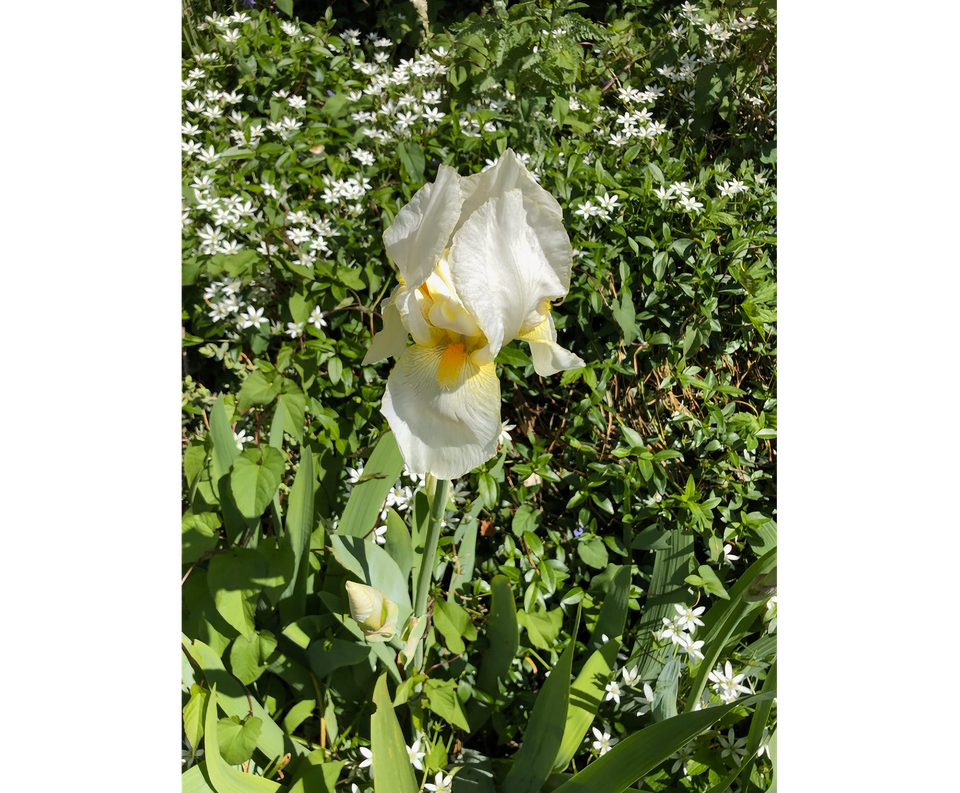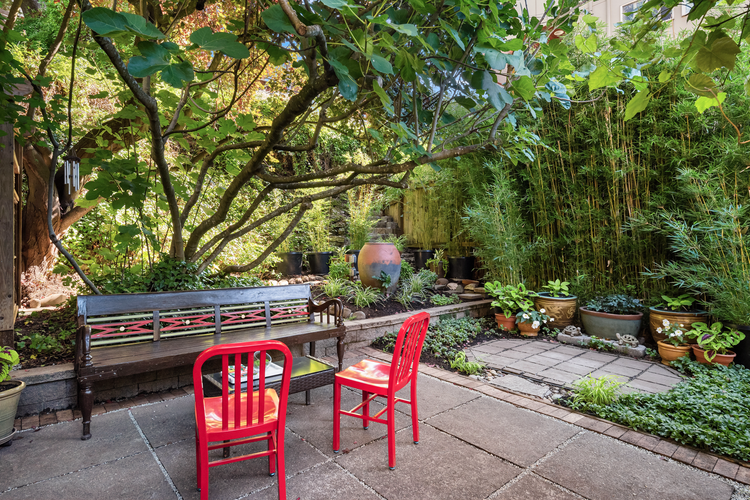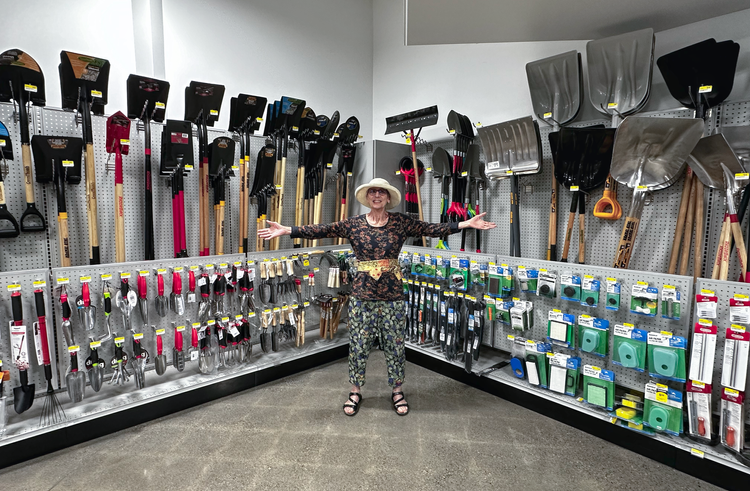Marie’s White Iris

As an artistic child growing up in 1950’s Kennewick, Washington, in what was then one of the more ramshackle neighborhoods on the outskirts of town, there were few people that I found inspiring, except for a retired artist/illustrator and his wife Marie, who lived in an old house across the street that was even tinier than ours.
Marie tended a beautiful flower garden on her property that included the lovely white iris pictured above, and on weekends I often joined her to walk through the lush and magical Eden she had created, as she stopped at each of the flowers to tell me their names.
The garden included spidery red dahlias, sunflowers, hedges of purple lilacs, and a large plot of stately iris, surrounded by a windbreak of tall poplars that shielded the plantings from the dry, eastern Washington winds. Inside this protected zone, a huge catalpa tree near the house unfurled its flowers every spring, and as the days grew warmer, their sweet, heady fragrance always drifted across the street to our backyard.


It was not until I was an adult that I realized how profoundly Marie’s love of gardening had subliminally influenced me to follow her same path later in my life.

A Gallery of Marie's Favorite Flowers





After my private garden tours, Marie would frequently entertain me inside her house with stories of growing up as a Russian-speaking immigrant in 1920’s Chicago. She told me that the other children in her school taunted her for her poor English and called her “Schwarzbrot,” because her lunches consisted only of dark rye bread and a chunk of smelly cheese.
But as if to somehow prove how far from that world she was now, she would finish up these conversations by going into her bedroom to bring out her collection of deliciously-scented perfumes, some pieces of heirloom jewelry, and delicate silk handkerchiefs with hand-crocheted trim for me to handle and enjoy. She always concluded these much-awaited visits together by serving me a little dish of ice cream.
In the view from my appreciative nine-year-old eyes, I saw Marie as a model of exotic and cultured elegance. After all, I thought, she did speak Russian! Her accomplished “artiste” suitor in 1920’s Chicago must have agreed with me, because according to Marie’s account, it was not long after they met that he asked her to marry him.

Marie and her husband, “Jerry,”—whose real name was Ulrich—never had children, most likely due to the frugal lifestyle they had to choose when the stock market crashed in 1929 and there were no more high-paying illustration jobs in once-roaring Chicago. They packed a few meager possessions for shipping by train—including Jerry’s tilting drawing table and their ornate, cast iron, shiny-zinc-trimmed pot-bellied stove—and headed off to unknown Washington State, where plenty of property foreclosures existed for adventurous souls.
During my frequent visits to their house in the mid 1950’s, Jerry sometimes worked with his watercolors on occasional commercial illustration jobs at his drawing table in the corner of the minuscule “living room.” He was always happy to answer questions about his materials and didn’t mind me observing his techniques.
I knew nothing about finances at age nine, but in retrospect it is likely that my father helped Marie and Jerry apply for belated Social Security benefits. I don’t know how else they could have survived. Their only real indulgences were the nightly “happy hours” they enjoyed in their kitchen near the open window. I could hear their spirited conversations from my bedroom across the street, as their voices became increasingly loud and more animated as the “hour” grew longer…
By the time I was in high school preparing to leave home, Jerry’s health was beginning to fail, and shortly before I left Kennewick for Seattle, he passed away. Marie was left alone with her garden, her memories, and the tireless deep affection she had for me—the unusual and artistically-talented neighbor girl who loved her garden as much as she did.

Since the property Marie had shared with Jerry since the Depression years was too cumbersome for her to maintain alone after his death, my father agreed to buy it. Marie needed the money, and it was likely that relatives she was in touch with back in Chicago were waiting to care for her. Sadly, my father let me know by phone that Marie had decided to return to Chicago before winter arrived, and I do not recall any formal goodbye. Although I was terribly sad, her own departure must have been much more painful.
The following year when I returned to Kennewick from Seattle for spring break, I was heartbroken to discover that my father had demolished Marie and Jerry’s old house, cut down all the trees, and was in the process of bulldozing the debris, including what remained of Marie’s once-magnificent garden. My father had never mentioned the “plans” he had to build a couple of spec houses on Marie’s property in the future, which he completed after I left Kennewick for good.

I never forgot Marie or her garden, and many years later when I started gardening on my own in Seattle, I tried to recreate the feeling of wonder and joy I felt as a child, when I was only a little taller than the irises she loved so deeply, especially the white ones. From various divisions I received over the years from friends and “old timers” gardens, I planted iris in my back yard and along the parking strip next to the sidewalk in front.
One spring, a lovely white iris spontaneously appeared among the purple iris plantings, which resembled one that Marie had grown in Kennewick long ago. With the help of a gardening group I joined that specialized in preserving historical iris, I was able to identify the mysterious white volunteer as “Winter Carnival,” which had been offered for sale in 1940 through an illustrated mail order catalog from Washington State.

This Art Nun journal post is dedicated to dear Marie, my first gardening inspiration and mentor, whose last name I never learned. She cultivated beauty where it was absent and would be happy to know that when I finally sold my Seattle house this past year and moved permanently to central Washington, I transported boxes and bags of my historical iris divisions—including “Winter Carnival”—to plant near my Tieton art loft. Sometime in the next few years, my beloved iris will once again be blooming close to me.
I think of Marie every time I close my eyes and remember the spicy fragrance of some of her favorite flowers. And I still miss her.


Member discussion